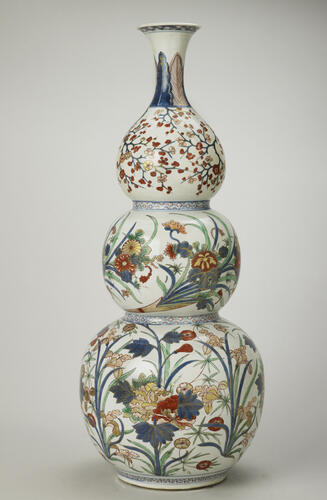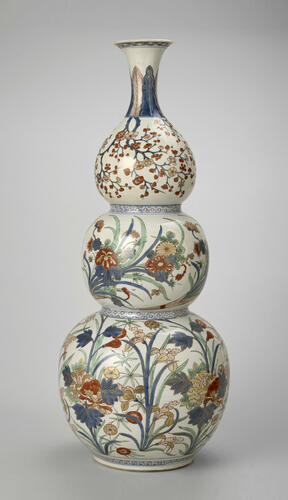-
1 of 253523 objects
Large triple-gourd vase Kangxi c.1700-20
Porcelain painted in underglaze blue, famille verte enamels and gilt | 70.7 x 26 cm (diameter) | RCIN 65
-
A large Chinese porcelain triple-gourd vase with globular lower part and smaller globular centre, the top shaped like a pear-shaped bottle with slayed mouth; low foot. Decorated in the Imari style in underglaze blue, famille verte enamels and gilt. Painted mainly in blue, red and gold, with sprays of peony and iris below, on the central section, chrysanthemum, and above, branches of flowering prunus, with a border of stiff leaves on the neck. Between the sections are narrow, diaper-patterned borders, and on the base, an empty double ring in blue.
Of the same form as two famille verte vases in the Collection (RCINs 58982 and 58983).
Wares in the Japanese Imari style were made in China during the early eighteenth century to meet the Western demand which was no longer being satisfied from Japan. They are characterised by painting in underglaze blue combined with iron-red enamel and gilding, and at times further colours from the famille verte palette. The style was especially favoured in France, where wares painted with armorial devices were ordered by the court. George IV acquired important vases in this style, as well as numerous plates of an everyday character, many of them enhanced with silver-gilt rims, which were perhaps intended for dessert use for banquets at the Royal Pavilion, Brighton.
Text adapted from Chinese and Japanese Works of Art in the Collection of Her Majesty The Queen: Volume I.Provenance
Almost certainly acquired by George IV. It is possibly the ‘large treble shaped japaned china bottle (two foot four ins [71.1 cm])’ sent from the Royal Pavilion, Brighton, to Buckingham Palace in 1848.
-
Creator(s)
(nationality)Acquirer(s)
-
Medium and techniques
Porcelain painted in underglaze blue, famille verte enamels and gilt
Measurements
70.7 x 26 cm (diameter)

